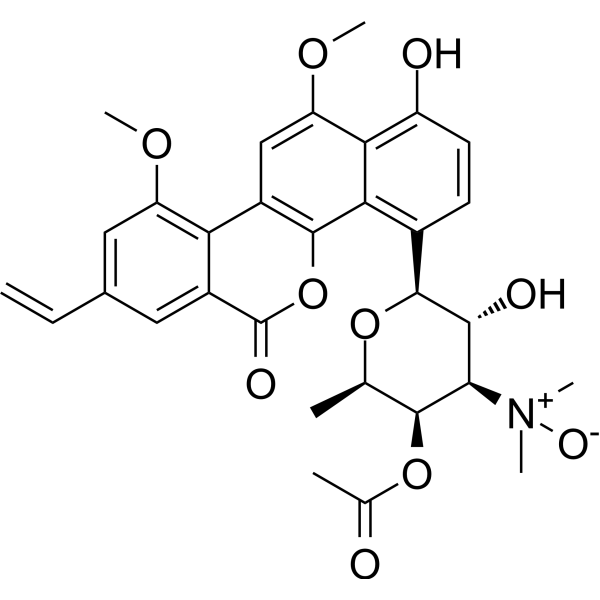- Anti-infection
- Antibody-drug Conjugate/ADC Related
- Apoptosis
- Autophagy
- Cell Cycle/DNA Damage
- Cytoskeleton
- Epigenetics
- GPCR/G Protein
- Immunology/Inflammation
- JAK/STAT Signaling
- MAPK/ERK Pathway
- Membrane Transporter/Ion Channel
- Metabolic Enzyme/Protease
- Neuronal Signaling
- NF-κB
- PI3K/Akt/mTOR
- PROTAC
- Protein Tyrosine Kinase/RTK
- Stem Cell/Wnt
- TGF-beta/Smad
- Vitamin D Related/Nuclear Receptor
- Others
Anti-infection
Apoptosis
Cell Cycle/DNA Damage
Epigenetics
GPCR/G Protein
- 5-HT Receptor
- Adenylate Cyclase
- Adhesion G Protein-coupled Receptors (AGPCRs)
- Adrenergic Receptor
- Amylin Receptor
- Angiotensin Receptor
- Apelin Receptor (APJ)
- Arf Family GTPase
- Arrestin
- Bombesin Receptor
- Bradykinin Receptor
- Cannabinoid Receptor
- CaSR
- CCR
- CGRP Receptor
- Chemerin Receptor
- Cholecystokinin Receptor
- CRFR
- CXCR
- EBI2/GPR183
Immunology/Inflammation
Membrane Transporter/Ion Channel
Metabolic Enzyme/Protease
- 11β-HSD
- 15-PGDH
- 17β-HSD
- 5 alpha Reductase
- Acetolactate Synthase (ALS)
- Acetyl-CoA Carboxylase
- Acetyl-CoA synthetase
- Acyltransferase
- ADAMTS
- Adiponectin Receptor
- Aldehyde Dehydrogenase (ALDH)
- Aldose Reductase
- Amine N-methyltransferase
- Aminoacyl-tRNA Synthetase
- Aminopeptidase
- Aminotransferases (Transaminases)
- Amylases
- Angiotensin-converting Enzyme (ACE)
- ANGPTL
- Apolipoprotein
Neuronal Signaling
Protein Tyrosine Kinase/RTK
Stem Cell/Wnt
- Compound Screening Libraries
- Bioactive Screening Libraries
- •Bioactive Compound Library
- Drug Repurposing Series
- •FDA-Approved Drug Library
- •Drug Repurposing Compound Library
- Natural Products Series
- •Natural Product Library
- •Natural Product-like Compound Library
- Metabolism Series
- •Human Endogenous Metabolite Compound Library
- Disease Related Compound Libraries
- Signaling Pathway Series
- Fragment Libraries
- Diversity Compound Libraries
- •50K Diversity Library
- •5K Scaffold Library
- •3D Diverse Fragment Library
- Virtual Screening
- •50K Virtual Diversity Library
- •10M Virtual Diversity Library
- Recombinant Proteins
- Cytokines and Growth Factors
- Immune Checkpoint Proteins
- CAR-T Related Proteins
- CD Antigens
- Fc Receptors
- Receptor Proteins
- Enzymes & Regulators
- Complement System
- Ubiquitin Related Proteins
- Viral Proteins
- Biotinylated Proteins
- Fluorescent-labeled Recombinant Proteins
- GMP-grade Proteins
- Animal-free Recombinant Proteins
- Protein Expression Service
- Custom Synthesis Service
- ADC-Related Custom Services
- PROTAC-Related Custom Services
- Cytokines and Growth Factors
- Immune Checkpoint Proteins
- CAR-T Related Proteins
- CD Antigens
- Fc Receptors
- Receptor Proteins
- Enzymes & Regulators
- Complement System
- Ubiquitin Related Proteins
- Viral Proteins
- Biotinylated Proteins
- Fluorescent-labeled Recombinant Proteins
- GMP-grade Proteins
- Animal-free Recombinant Proteins
- Others
- View More
CAR-T Related Proteins
- CD27 Ligand/CD70
- CD4
- CD19
- CD27 Ligand/CD70
- CD123
- CD138/Syndecan-1
- Epithelial Cell Adhesion Molecule (EpCAM)
- Folate Receptor 1
- GPC-3
- Guanylate Cyclase 2C
- ErbB2/HER2
- ErbB3/HER3
- c-Met/HGFR
- MSLN
- CA-125
- ROR1
- CEACAM-5
- CD314/NKG2D
- Prostate Specific Membrane Antigen
- CD319/SLAMF7
- TROP-2
- Siglec-6
- Folate Receptor alpha (FR-alpha)
- CD314/NKG2D
- Siglec-3/CD33
- CD27 Ligand/CD70
- CD319/SLAMF7
- ErbB2/HER2
- Siglec-3/CD33
- CD7
- MUC-1/CD227
CD Antigens
- T Cell CD Proteins
- B Cell CD Proteins
- NK Cell CD Proteins
- Macrophage CD Proteins
- Monocyte CD Proteins
- Stem Cell CD Proteins
- Platelet CD Proteins
- Erythrocyte CD Proteins
- Dendritic Cell CD Proteins
- Epithelial cell CD Proteins
- Endothelial cell CD Proteins
- Signal Transduction-related CD Proteins
- Cell Adhesion-related CD Proteins
Receptor Proteins
- Receptor Tyrosine Kinases
- Receptor Serine/Threonine Kinases
- Receptor Tyrosine Phosphatase
- Receptor Guanylyl Cyclase Family
- Cell Adhesion Molecules (CAMs)
- G-Protein-Coupled Receptors (GPCRs)
- Nuclear Receptor Superfamily
- Pattern Recognition Receptors
- Notch family
- Siglec
- Leukocyte Immunoglobin-like Receptors
- Killer-Cell Immunoglobulin-like Receptors
- Cytokine Receptors
Enzymes & Regulators
- Oxidoreductases (EC 1)
- Transferases (EC 2)
- Hydrolases (EC 3)
- Lyases (EC 4)
- Isomerases (EC 5)
- Ligases (EC 6)
- Translocases (EC 7)
- Matrix Metalloproteinases
- ADAMs/ADAMTSs
- Cathepsin
- Carboxypeptidase
- Angiotensin-converting Enzymes
- Caspase
- Carbonic Anhydrase
- Serine/Threonine Kinase Proteins
- Protein Tyrosine Kinases
- Phosphatase
- Topoisomerase
- Protease Inhibitors
- Protein Kinase Inhibitor Peptide (PKI)
- Cyclin-Dependent Kinase Inhibitor Proteins
- Cystatin Family
- Molecular Biology
- •Nucleic Acid Gel Electrophoresis
- •Vector Construction
- •Restriction Endonuclease
- •Materials
- •PCR & qPCR
- •RT-PCR
- •Sequencing
- Protein Biology
- •Protein Sample Preparation
- •Protein Purification
- •Protein Electrophoresis & WB
- •Labeling Kit
- •Multiple Fluorescent Staining
- •Immunoassay
- •Immunoprecipitation Kit
- Cell Biology
- •Cell Culture
- •Cell Analysis
- •3D Cell Culture
- •Cell Isolation
- View More
- Custom Synthesis Service
- Bulk and Custom Synthesis Service
- ADC-Related Custom Services
- PROTAC-Related Custom Services
- Custom Reference Standard Products
- Custom Peptide Synthesis
- Protein Expression Service
- Recombinant Antibody Expression Service
- Protein Crystal Structure Elucidation
- Oligonucleotide Synthesis
- Fluorescent labeling Service
- Custom Synthesis of Stable Isotope-Labeled Compounds
- One-stop CDMO Service
- One-stop Compound Screening Platform
- Virtual Screening
- Molecular dynamics simulation
- Cell-based Compound Screening
- Ion Channel Screening
- Kinase Screening Service
- Surface Plasmon Resonance (SPR) Assay Service
- GPCR Bioassay Screening Services
- Nuclear Receptor Screening Services
- Affinity Mass Spectrometry
- DEL Synthesis and Screening
- Molecular Interaction Assay Service
- Drug Target Identification Service
- AI-Driven Drug Screening
- Molarity Calculator
- Dilution Calculator



























![Ac-Pro-Leu-Gly-[(S)-2-mercapto-4-methyl-pentanoyl]-Leu-Gly-OEt](http://file.medchemexpress.eu/product_pic/hy-p4521.gif)


















































































































































































































































































































































































































![tert-Butyl N-[(1S,2S)-2-aminocyclohexyl]carbamate](http://file.medchemexpress.eu/product_pic/hy-30120.gif)

































































































































































































































![(S,R,S)-AHPC-CO-bicyclo[2.2.2]octane-CHO](http://file.medchemexpress.eu/product_pic/hy-159537.gif)





























































































































































































































































![(S,R,S)-AHPC-CO-spiro[3.3]heptane-Ph-CHO](http://file.medchemexpress.eu/product_pic/hy-159487.gif)




























































































































































































![(S)-2-[(tert-Butoxycarbonyl)amino]-3-iodopropionic acid methyl ester](http://file.medchemexpress.eu/product_pic/hy-z0424.gif)
















































































































































































![(S)-[1,1'-Binaphthalene]-2,2'-diamine](http://file.medchemexpress.eu/product_pic/hy-w007978a.gif)


















































































































































































































































![S-[2-(Iodo-4-azidosalicylamido)ethylthio]-2-thiopyridine](http://file.medchemexpress.eu/product_pic/hy-w776851.gif)















![[Lys4] Sarafotoxin S6c](http://file.medchemexpress.eu/product_pic/hy-p3563.gif)































![N-[S-Trityl-L-cysteinyl]glycine](http://file.medchemexpress.eu/product_pic/hy-w108635.gif)









































































































































































































































































![(2S)-2-[(tert-Butoxycarbonyl)amino]-3-(3-fluorophenyl)propionic acid](http://file.medchemexpress.eu/product_pic/hy-79288.gif)







![(S)-2-Amino-3-(benzo[b]thiophen-3-yl)propanoic acid](http://file.medchemexpress.eu/product_pic/hy-w022796.gif)





























































































![(2S)-2-[(tert-Butoxycarbonyl)amino]-3-(3,4-difluorophenyl)propionic acid](http://file.medchemexpress.eu/product_pic/hy-79165.gif)


































![[S-Methanethiosulfonylcysteaminyl]ethylenediamine-N,N,N',N'-tetraacetic acid](http://file.medchemexpress.eu/product_pic/hy-w127798.gif)





























































































































































































![L-Alanine, N-[(S)-(4-nitrophenoxy)phenoxyphosphinyl]-, 1-methylethyl ester](http://file.medchemexpress.eu/product_pic/hy-79333.gif)

























![N-[(6S)-6-Carboxy-6-(glycylamino)hexanoyl]-D-alanyl-D-alanine](http://file.medchemexpress.eu/product_pic/hy-148218.gif)









![(2S)-4-(Benzyloxy)-2-[(tert-butoxycarbonyl)amino]-4-oxobutanoic acid](http://file.medchemexpress.eu/product_pic/hy-z0615.gif)





























![(2S)-4-(benzyloxy)-2-{[(9H-fluoren-9-ylmethoxy)carbonyl]amino}-4-oxobutanoic acid](http://file.medchemexpress.eu/product_pic/hy-w002301.gif)













![(3R,5S)-5-([1,1′-Biphenyl]-4-ylmethyl)-3-methyl-2-pyrrolidinone](http://file.medchemexpress.eu/product_pic/hy-79080.gif)




![(1S,3aR,6aS)-(2S)-2-Cyclohexyl-N-(2-pyrazinylcarbonyl)glycyl-3-methyl-L-valyl-N-[(1R)-1-[2-(cyclopropylamino)-2-oxoacetyl]butyl]octahydrocyclopenta[c]pyrrole-1-carboxamide-d4](http://file.medchemexpress.eu/product_pic/hy-a0052s.gif)











































































![N3-(2S)-[2-(tert-Butoxycarbonyl)amino-3-(tert-butoxy carbonyl)]propyluridine](http://file.medchemexpress.eu/product_pic/hy-154647.gif)














































amino]-3-methylbutanoic acid](http://file.medchemexpress.eu/product_pic/hy-41051.gif)




























































![NH2-c[X-R-L-S-X]-K-G-P-(D-1Nal)](http://file.medchemexpress.eu/product_pic/hy-p3346.gif)

![Pinocembrin 7-O-[4′′,6′′-(S)-HHDP]-β-D-glucoside](http://file.medchemexpress.eu/product_pic/hy-n13117.gif)







![N-6-[rel-(2R,6S)-2,6-Dimethyl-4-morpholinyl]-3-pyridinamine-Sonidegib-d8](http://file.medchemexpress.eu/product_pic/hy-157571s.gif)






![N1-Methyl-N3-[(2S)-2-(t-butoxycarbonyl)amino-3-(t-butoxycarbonyl)] propylpseudouridine](http://file.medchemexpress.eu/product_pic/hy-152657.gif)



















![(S)-Deoxy-thalidomide-2,7-diazaspiro[3.5]nonane-C-Pip](http://file.medchemexpress.eu/product_pic/hy-168310.gif)


![(1R,5S)-Thalidomide-3,8-diazabicyclo[3.2.1]octane-Boc](http://file.medchemexpress.eu/product_pic/hy-163230.gif)








![2’-Deoxy-2’-fluoro-N3-(2S)-(2-amino-3-carbonyl] propyl-beta-D-arabinouridine](http://file.medchemexpress.eu/product_pic/hy-154662.gif)
![2’-Deoxy-2’-fluoro-N3-(2S)-[2-(tert-butoxy-carbonyl)-amino-3-carbonyl]propyluridine](http://file.medchemexpress.eu/product_pic/hy-154724.gif)
![(S)-Deoxy-thalidomide-2,7-diazaspiro[3.5]nonane-CH2-Me-PIP-Boc](http://file.medchemexpress.eu/product_pic/hy-168076.gif)
![NH2-c[X-R-L-S-X]-K-G-P-(D-2Nal)](http://file.medchemexpress.eu/product_pic/hy-p3347.gif)


![2H-1-Benzopyran-2-one, 6-[(1R,2S)-2,3-dihydroxy-1-methoxy-3-methylbutyl]-7-methoxy-](http://file.medchemexpress.eu/product_pic/hy-n10856.gif)
















































































































![Methyl (1S,3R)-2-(2-iodoacetyl)-1-(4-(methoxycarbonyl)phenyl)-2,3,4,9-tetrahydro-1H-pyrido[3,4-b]indole-3-carboxylate](http://file.medchemexpress.eu/product_pic/hy-401257.gif)















































![2,5-Dioxopyrrolidin-1-yl 4-(5-((3aS,4S,6aR)-2-oxohexahydro-1H-thieno[3,4-d]imidazol-4-yl)pentanamido)butanoate](http://file.medchemexpress.eu/product_pic/hy-w353622.gif)













![(1R,5S)-Thalidomide-3,8-diazabicyclo[3.2.1]octane-(1R,4r)-cyclohexane-NH-Boc](http://file.medchemexpress.eu/product_pic/hy-163226.gif)




























































![2,2,3,3,4,4,5,5,5-Nonafluoro-N-(2-(5-((3aS,4S,6aR)-2-oxohexahydro-1H-thieno[3,4-d]imidazol-4-yl)pentanamido)ethyl)pentanamide](http://file.medchemexpress.eu/product_pic/hy-172730.gif)
























































































































































![[6]-Gingerol](http://file.medchemexpress.eu/product_pic/hy-14615.gif)


































































































































































































































![[Nle20] H4 peptide (16−23)](http://file.medchemexpress.eu/product_pic/hy-p10570.gif)


![(R)-[1,1'-Binaphthalene]-2,2'-diamine](http://file.medchemexpress.eu/product_pic/hy-w007978.gif)














































































































































































![PROTAC PTK6 ligand-2,7-diazaspiro[3.5]nonane-Boc](http://file.medchemexpress.eu/product_pic/hy-163217.gif)


























































































































































































































































































































































































































































































































































































































































































































































































































































































































![5-[(2-Nitrophenyl)methylene]-2,4-thiazolidinedione](http://file.medchemexpress.eu/product_pic/hy-131044.gif)










































































































![[Ru(phen)3]Cl2](http://file.medchemexpress.eu/product_pic/hy-w145116.gif)









































































































































































































































































































![[Ala113]MBP(104-118)](http://file.medchemexpress.eu/product_pic/hy-p1289.gif)





















![[Ala107]MBP(104-118)](http://file.medchemexpress.eu/product_pic/hy-p1289a.gif)









































































































![[Ala113]MBP(104-118) TFA](http://file.medchemexpress.eu/product_pic/hy-p1289c.gif)
































![[Ala107]MBP(104-118) TFA](http://file.medchemexpress.eu/product_pic/hy-p1289b.gif)


























































































































































































































































































































































































































































































































































































































































































































































































![[5-(2-Thienyl)-3-isoxazolyl]methanol](http://file.medchemexpress.eu/product_pic/hy-w029719.gif)























































































































































































































































































































































































































































































































![N-[(Benzyloxy)carbonyl]-L-alanine](http://file.medchemexpress.eu/product_pic/hy-y0007.gif)












































































































































































































































































































































































































![9-β-D-[2'-Fluoro-2'-deoxy-arabinofuranosyl]-guanin](http://file.medchemexpress.eu/product_pic/hy-w334680.gif)













































































































































































































































































































































































![β-D-glucopyranosyl-[α-L-rhamnopyranosyl-(1→3)-βD-glucuronopyranosyl-(1→3)]-3β-hydroxyolean-12-ene28-oate](http://file.medchemexpress.eu/product_pic/hy-n9522.gif)






















































































































































































































































































































































































































































































































































































































































































































































































































































































































































































































































































![[Arg14,Lys15]Nociceptin](http://file.medchemexpress.eu/product_pic/hy-p1301.gif)


















































![c[Arg-Arg-Arg-Arg-Nal-Nal-Nal]](http://file.medchemexpress.eu/product_pic/hy-p3349.gif)





































![[D-Trp8]-γ-MSH](http://file.medchemexpress.eu/product_pic/hy-p1217.gif)

















































































































![[D-Trp8]-γ-MSH TFA](http://file.medchemexpress.eu/product_pic/hy-p1217a.gif)


























![[Arg14,Lys15]Nociceptin TFA](http://file.medchemexpress.eu/product_pic/hy-p1301a.gif)












![c[Arg-Arg-Arg-Arg-Dip-Dip-Dip]](http://file.medchemexpress.eu/product_pic/hy-p3348.gif)

































































































































































































































































































































































































































































































































































































































































































































































































































































































































































































































































































































![Nitrate Reductase (NAD[P]H), Pichia Pastoris (recombinant)](http://file.medchemexpress.eu/product_pic/hy-p2996b.gif)




























![1-Methyl-2-[(4Z,7Z)-4,7-tridecadienyl]-4(1H)-quinolone](http://file.medchemexpress.eu/product_pic/hy-n9530.gif)










































































































































![Poly[bis(4-phenyl)(2,4,6-trimethylphenyl)amine]](http://file.medchemexpress.eu/product_pic/hy-w391671.gif)











































2](http://file.medchemexpress.eu/product_pic/hy-158117.gif)


















